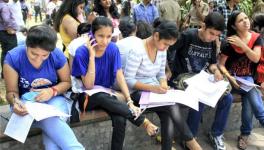Govt Underspending on Education Spurs Protests Against Fee Hikes

A protest gathering organised at Pondicherry University. Image Courtesy: The Facebook
New Delhi: The students of Pondicherry University (PU) on the morning of Thursday, February 6, started an indefinite protest, demanding rollback of tuition fee hike and scrapping of transportation fee charged to the day scholars. The council is also demanding implementation of 25% reservation for students from Puducherry. The Pondicherry University Students’ Council (PUSC), which is leading the protest, has resolved to continue their demonstration until their demands are met.
Pondicherry University, however, is not the only university or institution to have witnessed a sudden fee hike in the recent past. The over five years of the Narendra Modi government at the Centre has been marred with continuous attacks on public-funded higher attention, attempts at privatising institutions, diminishing autonomy of the University Grants Commission (UGC) with the establishment of Higher Education Financing Agency (HEFA) in May 2017.
The main brunt of these measures is being borne by the youth of the country, as higher education continues to become less accessible and affordable. The Indian Institute of Mass Communication (IIMC), Indian Institute of Technology (IIT), National Law University (NLU), and Jawaharlal Nehru University (JNU) are some of the institutions that witnessed a huge fee hike during the later half of 2019.
In the last 10 years, the higher education system in the country has seen a massive expansion. India currently has 993 universities, around 39,931 colleges, and 10,275 stand-alone institutions, according to the All India Survey on Higher Education, 2019. According to the report, which was published in August 2019, total enrolment in higher education was estimated to be 3.74 crore, with 1.92 crore male and 1.82 crore female students. Women constitute 48.6% of the total enrolment. Gross Enrolment Ratio (GER) in Higher education, in India is 26.3%, which is calculated for 18-23 years of age group. GER for male and female population is 26.3% and 26.4% respectively. For Scheduled Castes, it is 23% and for Scheduled Tribes, it is 17.2% as compared to the national GER of 26.3%. In 2004, the GER in Higher Education was 10%.
However, the expansion of the higher education system is not in tandem with the increase in GER. More than 30% of India’s youth are neither employed nor in any educational or training institutes. Unregulated privatisation of higher education has also resulted in the proliferation of private institutions. More than 77.8% of colleges are run by private entities, which account for 66.4% of the total enrolment. This shows how more and more students are being forced to pursue higher education in significantly more expensive private institutions because of the decreasing public spending on higher education.
In the Union Budget for 2020-2021, Rashtriya Uchchatar Shiksha Abhiyan (RUSA), the only Centrally-sponsored scheme of Ministry of Human Resource Development (MHRD) responsible for improving the quality of State Universities and Colleges, has experienced a major cut of Rs.1,800 crore, that is, a reduction of 86%, from previous year’s allocation. In 2019-2020, the allocation for the scheme was Rs 2,100 crore. In response to RTI applications filed by The Indian Express, the Department of Higher Education, under MHRD, said it had spent only Rs 801.83 crore of the total Budget allocation of Rs 2,100 crore for the RUSA scheme till December 16, 2019.
The government’s project of establishing 10 world class institutions has got an allocation of Rs. 500 crore in 2020-21. However, an RTI response reveals that out of Rs 400 crore allocated in 2019-20 (BE), only 21.2%, that is, Rs 80 crore, was spent till December 2019. Despite its inability to spend the allocated amount, the Centre made a higher allocation to the project in this budget.

The Indian Express reported that the department was allocated Rs 608.87 crore for the Total Research and Innovation scheme, but till that date only 25% of the allocation was utilised. The Scheme for Promotion of Academic and Research Collaboration was given Rs 130 crore, but only Rs 80 crore was spent until December 16, 2019.
The Rs 95 crore allocated to the Uchchatar Avishkar Abhiyan scheme was unspent till that date. Similarly, the Rs 50 crore allocated to the Transformational and Advanced Research in Science was not spent at all. The Prime Minister’s Fellowship for Research was given Rs 50 crore, but only Rs 18.07 crore was spent, that is, 36% of the allocated amount.
The Centre for Budget and Governance Accountability (CBGA) said in its analysis of the Budget for 2020-2021, “In order to reap the benefits of the demographic dividend and produce a skilled labour force, a substantial jump is needed in the budgetary allocation for the higher education sector. But the budget has proposed a meagre 3 per cent increase in the higher education outlay over the previous year’s estimate.”
Get the latest reports & analysis with people's perspective on Protests, movements & deep analytical videos, discussions of the current affairs in your Telegram app. Subscribe to NewsClick's Telegram channel & get Real-Time updates on stories, as they get published on our website.
























